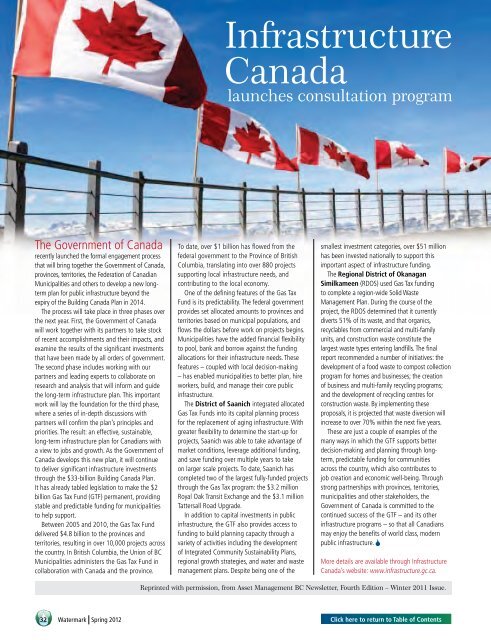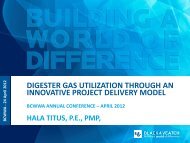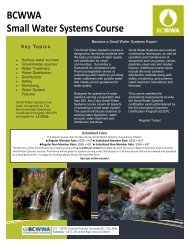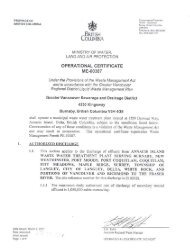Download - BC Water & Waste Association
Download - BC Water & Waste Association
Download - BC Water & Waste Association
You also want an ePaper? Increase the reach of your titles
YUMPU automatically turns print PDFs into web optimized ePapers that Google loves.
The Government of Canada<br />
recently launched the formal engagement process<br />
that will bring together the Government of Canada,<br />
provinces, territories, the Federation of Canadian<br />
Municipalities and others to develop a new longterm<br />
plan for public infrastructure beyond the<br />
expiry of the Building Canada Plan in 2014.<br />
The process will take place in three phases over<br />
the next year. First, the Government of Canada<br />
will work together with its partners to take stock<br />
of recent accomplishments and their impacts, and<br />
examine the results of the significant investments<br />
that have been made by all orders of government.<br />
The second phase includes working with our<br />
partners and leading experts to collaborate on<br />
research and analysis that will inform and guide<br />
the long-term infrastructure plan. This important<br />
work will lay the foundation for the third phase,<br />
where a series of in-depth discussions with<br />
partners will confirm the plan’s principles and<br />
priorities. The result: an effective, sustainable,<br />
long-term infrastructure plan for Canadians with<br />
a view to jobs and growth. As the Government of<br />
Canada develops this new plan, it will continue<br />
to deliver significant infrastructure investments<br />
through the $33-billion Building Canada Plan.<br />
It has already tabled legislation to make the $2<br />
billion Gas Tax Fund (GTF) permanent, providing<br />
stable and predictable funding for municipalities<br />
to help support.<br />
Between 2005 and 2010, the Gas Tax Fund<br />
delivered $4.8 billion to the provinces and<br />
territories, resulting in over 10,000 projects across<br />
the country. In British Columbia, the Union of <strong>BC</strong><br />
Municipalities administers the Gas Tax Fund in<br />
collaboration with Canada and the province.<br />
32<br />
<strong>Water</strong>mark Spring 2012<br />
Infrastructure<br />
Canada<br />
launches consultation program<br />
To date, over $1 billion has flowed from the<br />
federal government to the Province of British<br />
Columbia, translating into over 880 projects<br />
supporting local infrastructure needs, and<br />
contributing to the local economy.<br />
One of the defining features of the Gas Tax<br />
Fund is its predictability. The federal government<br />
provides set allocated amounts to provinces and<br />
territories based on municipal populations, and<br />
flows the dollars before work on projects begins.<br />
Municipalities have the added financial flexibility<br />
to pool, bank and borrow against the funding<br />
allocations for their infrastructure needs. These<br />
features – coupled with local decision-making<br />
– has enabled municipalities to better plan, hire<br />
workers, build, and manage their core public<br />
infrastructure.<br />
The district of saanich integrated allocated<br />
Gas Tax Funds into its capital planning process<br />
for the replacement of aging infrastructure. With<br />
greater flexibility to determine the start-up for<br />
projects, Saanich was able to take advantage of<br />
market conditions, leverage additional funding,<br />
and save funding over multiple years to take<br />
on larger scale projects. To date, Saanich has<br />
completed two of the largest fully-funded projects<br />
through the Gas Tax program: the $3.2 million<br />
Royal Oak Transit Exchange and the $3.1 million<br />
Tattersall Road Upgrade.<br />
In addition to capital investments in public<br />
infrastructure, the GTF also provides access to<br />
funding to build planning capacity through a<br />
variety of activities including the development<br />
of Integrated Community Sustainability Plans,<br />
regional growth strategies, and water and waste<br />
management plans. Despite being one of the<br />
smallest investment categories, over $51 million<br />
has been invested nationally to support this<br />
important aspect of infrastructure funding.<br />
The regional district of okanagan<br />
similkameen (RDOS) used Gas Tax funding<br />
to complete a region-wide Solid <strong>Waste</strong><br />
Management Plan. During the course of the<br />
project, the RDOS determined that it currently<br />
diverts 51% of its waste, and that organics,<br />
recyclables from commercial and multi-family<br />
units, and construction waste constitute the<br />
largest waste types entering landfills. The final<br />
report recommended a number of initiatives: the<br />
development of a food waste to compost collection<br />
program for homes and businesses; the creation<br />
of business and multi-family recycling programs;<br />
and the development of recycling centres for<br />
construction waste. By implementing these<br />
proposals, it is projected that waste diversion will<br />
increase to over 70% within the next five years.<br />
These are just a couple of examples of the<br />
many ways in which the GTF supports better<br />
decision-making and planning through longterm,<br />
predictable funding for communities<br />
across the country, which also contributes to<br />
job creation and economic well-being. Through<br />
strong partnerships with provinces, territories,<br />
municipalities and other stakeholders, the<br />
Government of Canada is committed to the<br />
continued success of the GTF – and its other<br />
infrastructure programs – so that all Canadians<br />
may enjoy the benefits of world class, modern<br />
public infrastructure.<br />
More details are available through Infrastructure<br />
Canada’s website: www.infrastructure.gc.ca.<br />
Reprinted with permission, from Asset Management <strong>BC</strong> Newsletter, Fourth Edition – Winter 2011 Issue.<br />
click here to return to table of contents









